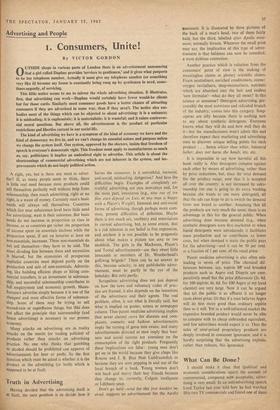Truth in Advertising
Having decided that the advertising itself is at fault, the next problem is to decide how it harms the consumer. Is it untruthful, immoral, anti-social, misleading, dangerous? And here the difficulties begin. Examples of completely un- truthful advertising are rare nowadays and, for the most part, innocuous (e.g., nine out of ten film stars depend on Lux; or any man is happy with a Player's Weight). Immoral and anti-social forms of advertising, though perhaps more com- mon, present difficulties of definition. Maybe there is too much sex, snobbery and materialism in current advertising, but, to some extent, that is a risk inherent in our belief in free expression, and anyhow it is not possible to be pragmatic about what makes a picture too sexy or too snobbish. The girls in the Mackeson, Player's and Tootal advertisements—are they sweet little innocents or members of Dr. Weatherhead's golliwog brigade? There can be no answer to this, because salacity, in any publishable adver- tisement, must be partly in the eye of the beholder. But only partly.
Scrupulous advertising does not just depend on how the laws and voluntary codes of prac- tice are framed, it also depends on the intentions of the advertisers and their agents. The real problem, often,, is not what is literally said, but what is implied on poster, screen or newspaper column. Thus patent medicine advertising implies (but never claims) cures for diseases and com- plaints; cosmetic and fashion advertisements imply the turning of geese into swans; and many advertisements directed at men imply that busi- ness and social success are attendant on the consumption of the right products. Frequently these implications are false: young men don't get on in the world because they give chaps like Roscoe and J. B. Blue Nun Liebfraumilch or because they are seen popping in and out of the local branch of a bank. Young women don't win back and marry their boy friends because they change to, currently, Colgate toothpaste or Lifebuoy soap.
Don't go bald—send for this free booklet in- stead, suggests an advertisement for the Apollo treatment. It is illustrated by three pictures of the back of a man's head, two of them fairly bald, but the third, labelled after Apollo treat- ment, normally hirsute. Whatever the small print may say, the implication of this type of adver- tisement is that baldness can now be remedied; a most dubious contention.
Another practice which is valueless from the consumers' point of view is the making of meaningless claims or phoney scientific claims. Foam neutralisers, enriched conditioners, ozone/ oxygen revitalisers, deep-moisturisers, nutrients which are absorbed into the hair and endless 'new formulas'—what do they all mean? Is this science or nonsense? Detergent advertising, pre- sumably the most notorious and ridiculed branch of the industry,' comes into this category. Soap- operas are silly because there is nothing new to say about synthetic detergents. Everyone knows what they will do and how well they do it—but the manufacturers won't admit this and therefore expect their marketing and advertising men to discover unique selling points for each product . . . hence whiter than white, balanced lather, does not harm the hands, etc. etc.
It is impossible to say how harmful all this bunk really is. Also detergents compete against each other by means of advertising, rather than by price reductions, but, since the total demand for the product range, now that it is accepted all over the country, is not increased by sales- manship (no one is going to do extra washing because she wants to use more detergent), all that the ads can hope to do is switch the demand from one brand to another. Assuming that all the products are very much the same, there is no advantage in this for the general public. When advertising does increase demand (e.g., when synthetic detergents were first marketed or when liquid detergents were introduced), it facilitates mass production and so contributes to lower costs, but when demand is static the public pays for the advertising—and it can be 50 per cent. or a fraction of 1 per cent. of the retail price.
Patent medicine advertising is also often mis- leading in terms of price. The chemical dif- ferences between, say, aspirin BP and branded products such as Aspro and Disprin are com- paratively small but the price differences (2s. 6d. for 100 aspirin; 6s. 6d. for 100 Aspro at my local chemist) are very large. Now it can be argued that (a) the public is so affluent it no longer cares about price; (b) that if a man believes Aspro will do him more good than ordinary aspirin then so it will. Yet in a well-informed market the expensive branded product would never be able to compete with its cheap unbranded equivalent, and few advertisers would expect it to. Thus the sales of over-priced proprietary products are - deeply involved in consumer ignorance, and it is hardly surprising that the advertising exploits, rather than reduces, this ignorance.






























 Previous page
Previous page